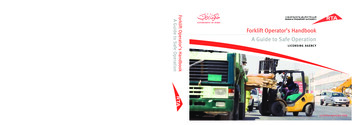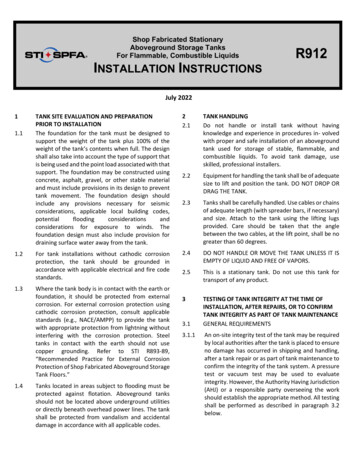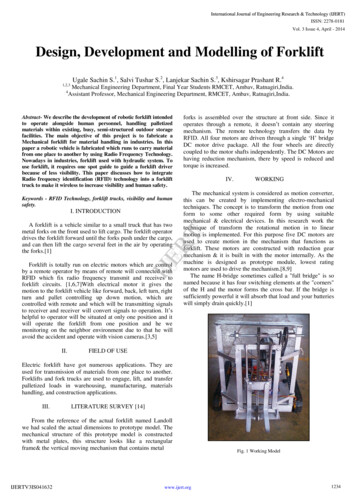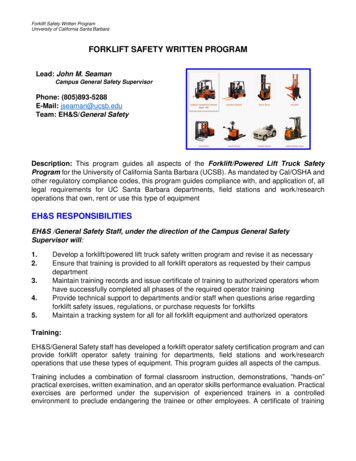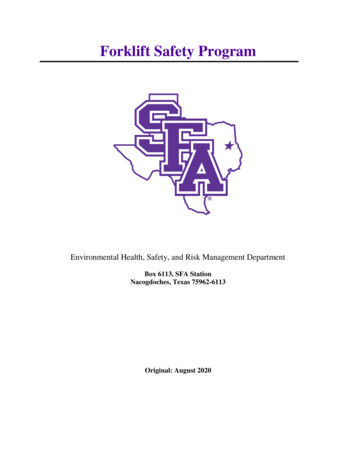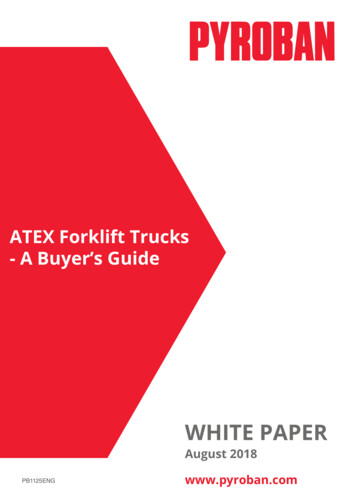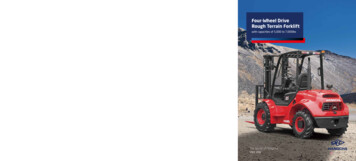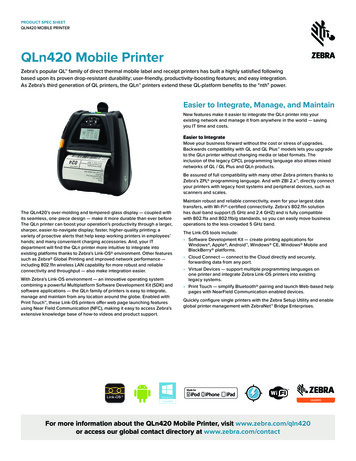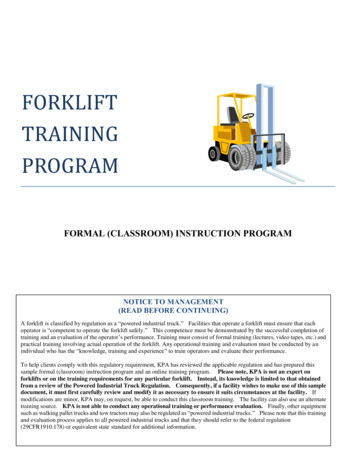
Transcription
FORKLIFTTRAININGPROGRAMFORMAL (CLASSROOM) INSTRUCTION PROGRAMNOTICE TO MANAGEMENT(READ BEFORE CONTINUING)A forklift is classified by regulation as a “powered industrial truck.” Facilities that operate a forklift must ensure that eachoperator is “competent to operate the forklift safely.” This competence must be demonstrated by the successful completion oftraining and an evaluation of the operator’s performance. Training must consist of formal training (lectures, video tapes, etc.) andpractical training involving actual operation of the forklift. Any operational training and evaluation must be conducted by anindividual who has the “knowledge, training and experience” to train operators and evaluate their performance.To help clients comply with this regulatory requirement, KPA has reviewed the applicable regulation and has prepared thissample formal (classroom) instruction program and an online training program. Please note, KPA is not an expert onforklifts or on the training requirements for any particular forklift. Instead, its knowledge is limited to that obtainedfrom a review of the Powered Industrial Truck Regulation. Consequently, if a facility wishes to make use of this sampledocument, it must first carefully review and modify it as necessary to ensure it suits circumstances at the facility. Ifmodifications are minor, KPA may, on request, be able to conduct this classroom training. The facility can also use an alternatetraining source. KPA is not able to conduct any operational training or performance evaluation. Finally, other equipmentsuch as walking pallet trucks and tow tractors may also be regulated as “powered industrial trucks.” Please note that this trainingand evaluation process applies to all powered industrial trucks and that they should refer to the federal regulation(29CFR1910.178) or equivalent state standard for additional information.
FORKLIFT TRAINING PROGRAMCLASSROOM INSTRUCTION OUTLINEI.Introduction:A.Definition:A “powered industrial truck” is any mobile power-propelled truck used to carry, push, pull, lift, stack or tiermaterials. Powered industrial trucks can be ridden or controlled by a walking operator. A forklift is a poweredindustrial truck. Other examples include walking pallet trucks and tow tractors.This training program is for forklift operators.B.Differences Between a Forklift and an Automobile:A forklift is basically a lever on wheels. An important difference between an automobile and a forklift is that aforklift steers with the rear wheels and has a front drive axle. Also, a forklift travels in reverse almost as muchtime as it travels forward. As a result, forklift transmissions usually have forward and reverse speeds of equalgearing and power. In addition, most forklifts are powered by either LPG (propane) or electric batteries. Someadditional differences between a forklift and an automobile include:On most forklifts there are no speedometers.When an operator drives a forklift, his body is exposed to temperatures, dust, chemical emissions andother environmental conditions.Unlike automobiles, most forklifts allow for only one person – the operator.C.Reason for Forklift Training:Annual forklift/powered industrial truck accident toll:o 100 fatalitieso 36,000 serious injuriesOSHA’s estimate: 20 – 25% of accidents are caused, at least in part, by inadequate operator training.II.Training Requirements:OSHA regulations mandate that forklift operators receive both formal (classroom) instruction and practical trainingon the forklift(s) they will operate. This training class is intended to satisfy the requirement for the formal/classroominstruction. In addition to providing a regulatory overview, this instruction will focus on providing:General guidelines on forklift operation.General safety guidelines.After this training is completed, individuals who operate forklifts should receive practical training so that they willbe able to properly and safely operate the forklift(s) at their facility. This practical training will include:Hands-on training on how to operate the forklift.Re-training as may be needed to ensure continued safe operation of the forklift.Refresher training at least once every three years.Again, this training is required for all employees that operate a forklift.Forklift Training Program KPA LLC.Page 28.09vFed
III.Classroom Training Elements:A.Truck Related Topics:1.General information on typical forklift controls:Ignition: Insert correct key in the ignition and turn it clockwise to activate the starter.Make sure the brake is set and the clutch depressed.Brake foot pedal: Step on the brake to slow the forklift. The greater the pressure, thefaster the forklift will stop.Hand brake: The hand brake is usually on the right side of the vehicle. It is to be used fora parking brake or in the event of an emergency. It must be set whenever you get off theforklift. Usually one pulls upward to set the brake and pushes forward to release it. DONOT OPERATE A FORKLIFT WITH THE HAND BRAKE ON.Gearshift lever: The gearshift lever is usually located to the left side of the steeringcolumn, just under the steering wheel. Putting the lever in forward (or up) position willcause the forklift to move forward. The middle position is neutral while to back, or rearposition is reverse. THE LEVER SHOULD BE IN THE NEUTRAL POSITIONPRIOR TO STARTING A FORKLIFT.Fork control and attachments: The fork control lever is typically located to the right ofthe steering column, either on the dash or to the right of the seat. Raising the lever (orpulling it backwards) normally raises the forks. Depressing the lever (or pushing itforward) will normally lower the forks.Mast tilt: The lever to control the tilt of the mast is usually located to the right of theforklift control lever. Raising the lever (or pulling it backward) will normally tilt the top ofthe mast back towards the forklift. Pushing forward (or depressing) the lever will normallymove the top of the mast forward – away from the forklift.Horn: The horn is typically located at the top of the steering column, near or at the centerof the steering wheel. This is similar to automobiles.2.Steering and Maneuvering:Steering: As noted earlier, the rear wheels do the steering on a forklift. Consequently, becareful to allow enough clearance when turning a corner.o Steer the forklift close to the inside corner and start the turn just after the front wheelspass the inside corner.o Appropriate steering techniques should be used when turning in confined and limitedspaces.o Always take care to ensure that no personnel are within the truck’s danger zone.o The forklift responds quickly when the steering wheel is turned. DO NOT MAKETURNS AT HIGH SPEED.Proper speed: There are no speedometers on forklifts.o Use good judgment according to the area in which you are traveling. Do not, however,exceed 6 mph or, if more restrictive, any onsite speed limit established by facilitymanagement.o Use especially slow speeds in confined or well- traveled areas. Always use slow speedsuntil you are totally familiar with the particular forklift you are operating as well as thework areas through which you are traveling.Ramps and grades: Go up and down grades and ramps slowly. Always travel with theforks pointing uphill. When operating a loaded forklift, drive forward when going up rampsand backward (in reverse) when going down ramps.Viewing direction: While in motion, always look in the direction you are heading.Forklift Training Program KPA LLC.Page 38.09vFed
Horn use: Stop and sound the horn in areas where your view is blocked and before turningall corners.Brake use: Use the brake when coming to a stop. Do not stop by putting the forklift inreverse.Rules of the road: Observe all traffic regulations, including any posted speed limits (forforklifts) and forklift stop signs.o When crossing a public street, use the closest gate and drive the shortest and mostdirect route.o Yield the right of way to all street traffic.o Cross railroad tracks diagonally whenever possible and never park closer than 8 ½ feetfrom the center of a railroad track.o Avoid running over loose objects on the roadway.Pedestrian safety: Never drive a forklift up to anyone standing in front of a fixed object.Never drive with forks elevated.Loading docks: While operating a forklift on a loading dock, do not drive close to the edgeof the ramp or platform.Utility use: Do not use a forklift to open or close doors.3.Visibility:Direction of travel: The forklift driver should always look in the direction of travel.o If the load obstructs the operator’s viewpoint, the lift should be driven in reverse.Blind corners: Stop and sound the horn in areas where your view is blocked and beforeturning all corners.4.Forklift Use and Operations:Load Handling: Use extreme care when tilting a load forward or backward, particularlywith high stacking.o Tilt elevated forks forward only to place them under an elevated load.o Do not tip an elevated load forward except when in the process of placing the load on arack or stack.Tractor Trailer Use: When loading and unloading trucks and trailers, ensure that thewheels of these units are first chocked with brakes set in order to prevent movement.o Before driving a forklift onto a truck or trailer, check the flooring for breaks andweaknesses.o Ensure that the dock plate is secure and safe for travel into and out of the trucks andtrailers that require loading and unloading.o Look over dock boards slowly and never exceed their rated capacity.Lifting Capacity: Note the lifting capacity of your forklift and do not exceed these limits.o This loading capacity reading should be printed in clear view of the operator.o In addition to other dangers, overloading a forklift significantly affects its steering.Traveling with a Load: Carry your load as low to the ground as possible (approximatelysix inches above the ground).o You may need to raise the forks slightly before climbing a ramp so that they do notscrape the ground.o Watch out for low overhead items such as gas, air and sprinkler pipes.o Never place a load down in front of a fire door.Picking up and stacking pallets:o Make sure that the top surface of the forks is at the same angle as the top of the pallet.o Approach the load squarely so that the corners of the pallet are at an equal distancefrom the side of the forks and with the forks half way between the top and bottom of thepallet.Forklift Training Program KPA LLC.Page 48.09vFed
ooPlace the forks as far as possible under the load.Raise the forks slowly until they are touching the underside of the pallet top. Makesure that the pallet is not touching or caught on any other object.o Never pick up a pallet that appears to be unsafely loaded. If the load is off center, try tocenter it before lifting. If it cannot be centered, then separate the forks as wide aspossible and try to position them equidistant from the center of gravity of the load. IFIN DOUBT, DO NOT LIFT THE LOAD. ASK YOUR SUPERVISOR FORGUIDANCE.o Slowly lift the load. After it is clear of all obstacles, tilt the mast slightly back.o Always travel in the direction you can see.Picking up two pallets at a time:o Place the first pallet squarely on top of the second. Make sure that the top pallet isstable and that the bottom pallet has an even load.o Be sure to check the total weight of the combined load before picking up the pallets tobe sure that it is not greater than the capacity of the forklift. If it is, or if you are unsureof this, do not attempt to pick up the load.o Pick up the pallets using the same procedure outlined above for picking up and stackingpallets.o Never drive a forklift forward with a double load.o Start transporting the load very slowly making sure that the steering will respond bymaking a slight turn. If the forklift does not respond properly or does not respond at all,then the load is too heavy. Set it down and move one pallet at a time.Positioning loads at destination:o Slowly approach the area where the pallet is to be placed.o When at the destination, smoothly stop the forklift and straighten the mast so that thebottom of the pallet is at the same angle as the ground.o Align the pallet to the exact placement wanted and lower the load.o Lower the forks so that they are in the open space between the upper and lower levelsof the pallet. Slowly back away being careful to look to the rear.Forklift capacity:o Know the lifting capacity of your forklift and do not exceed these limits. This loadcapacity should be printed in clear view of the operator. In addition to other dangers,overloading a forklift significantly affects its steering.o The operator of the forklift must always ensure that the load is within the rated capacityfor the forklift, taking into account the task to be performed.o If a loaded forklift does not steer properly, the load is too heavy or is otherwise unsafeto transport. Set the load down and advise your supervisor.5.Vehicle inspection and maintenance:Each day, prior to operating the forklift, the operator should complete a pre-operational forklift safetychecklist. You may want to document these inspections to show that they are being conducted. Acomplete list of items to check can normally be found in the operator’s manual and typically includesmany of the following:BrakesTiresOilFuelWaterHydraulic FluidForksMastLoad BackrestOverhead GuardGaugesHornLightsSteeringLevers/ControlsThe forklift should also be inspected to ensure that it is clean and free of debris. It should be drivenforward for several feet and braked to a stop to ensure brakes are working properly. Anything out of theForklift Training Program KPA LLC.Page 58.09vFed
ordinary should be reported to your supervisor before you begin driving the forklift.OSHA has developed sample checklists for a variety of powered industrial trucks for use in situationswhere the operator’s manual does not provide machine specific inspection items. These checklistsshould be used as an example and should be modified to the specific equipment used at your facility.The checklists are available in Attachment B of this program.6.Refueling/battery recharging:LPG (propane): When replacing a propane tank of fuel follow these procedures and safetyguidelines:1.2.3.4.5.6.7.Set the hand brake on the forklift.Close the valve on the LPG tank.Remove the connecting hose.Remove the LPG tank.Replace it with a full unit.Tighten the securing strap.Attach the hose to the LPG tank to fuel the forklift.oThe person changing LPG tanks should wear gloves to prevent frostbite from LPG thatmay potentially escape during a refueling process.LPG tanks should never be filled while the engine is running.If LPG tanks are refilled onsite, ensure that all refilling is performed outdoors and thatcare is taken to avoid overfilling the tank.ooBatteries: If your forklift is the electric type and will not immediately be used by the nextshift, take it to the battery charging area. Properly position it and set the brake beforeattempting to change or charge batteries. Connect charging cables and make sure they aresecure.o Before charging batteries, ensure cells are filled with enough distilled water to coverthe top of the plates in the cell. Do not overfill.o Take care to ensure that vent caps are functioning properly. Open the battery (orcompartment) cover(s) to release heat and gases that may build up during charging.o Take care to prevent open flames, sparks or electric arcs in battery charging areas.Keep tools and other metallic objects away from the top of uncovered batteries.7.General operating limitations for forklifts:Have any unusual operating noises or odors checked immediately.Do not operate a forklift with a leak in the fuel, oil or hydraulic systems.Do not operate internal combustion forklifts in unventilated areas or inside for extendedperiods of time.Do not drive a forklift that is in need of repair, defective, or in any way unsafe. Ensure anysuch forklift is tagged “inoperable” until repairs are completed.Keep engine oil level at “full” on the dipstick.Clean up any spillage of oil or hydraulic fluid from the forklift before starting or restartingthe engine.Keep the forklift in a clean condition, free of lint, excess oil and grease. Follow precautionsregarding toxicity, ventilation, and fire hazards when using a cleaning agent or solvent onthe forklift.Forklift Training Program KPA LLC.Page 68.09vFed
8.Additional safety rules:Never operate a piece of equipment for which you are not qualified.Never allow a person to stand or pass under the elevated portion of any forklift, whetherloaded or empty.Use only approved safety platforms to raise or lower personnel with a forklift.Never permit a rider on a forklift especially on the forks themselves.Never place arms, legs or feet between the uprights of the mast or outside the running linesof the forklift.Be alert to the presence of pedestrians. Give pedestrians the right of way.Stunt driving and horseplay are strictly prohibited.Slow down when operating the forklift on wet or slippery floors.Set the brakes and lower the forks fully every time you get off your forklift.When parked on an incline, lower the load and tilt it against the backrest (mast).Set brakes and chock wheels. Turn power off.If you cannot see your forklift or are more than 25 feet away from it, it is consideredunattended. When a forklift is unattended, fully lower the forks, shut off the power, and setthe brakes.Never smoke in the charging area.Allow only authorized personnel to perform fueling, refueling or recharging operations.Report all accidents, even if no one was hurt.B.Workplace Related Topics:Discuss the following facility specific circumstances:1.2.3.4.5.6.7.8.9.Surface conditions where forklift will be operated.Composition and stability of loads typically transported.Particular issues involving stacking, unstacking and general load manipulation.Pedestrian traffic and areas of the facility where operators should be especially attentive to the matter.Any narrow aisles or restricted areas that might constrain forklift operation.Areas at the facility where the forklift/operator might be exposed to special hazards.Location and characteristics of ramps and other sloped surfaces that could affect forklift stability.Any closed environments or areas of insufficient ventilation in which a forklift may have to operate.Other unique or potentially hazardous conditions at the facility.Forklift Training Program KPA LLC.Page 78.09vFed
Forklift Operating RulesEvery employer using industrial trucks or industrial tow tractors shall post and enforce a set of operating rules including the appropriate rules listed below:1.2.3.4.5.6.7.8.9.10.11.12.13.14.Only drivers authorized by the employer and trained in the safeoperations of industrial lift trucks shall be permitted to operatesuch vehicles. Methods shall be devised to train operators insafe operation of powered industrial trucks.Stunt driving and horseplay are prohibited.No riders shall be permitted on vehicles unless provided withadequate riding facilities.Employees shall not ride on the forks of lift trucks.Employees shall not place any part of their bodies outside therunning lines of an industrial truck or between mast uprights orother part of the truck where shear or crushing hazards exist.Employees shall not be allowed to stand, pass, or work underthe elevated portion of any industrial truck, loaded or empty,unless it is effectively blocked to prevent it from falling.Drivers shall check the vehicle at least once per shift, and if it isfound to be unsafe, the matter shall be reported immediately toa foreman or mechanic, and the vehicle shall not be put inservice again until it has been made safe. Attention shall begiven to the proper functioning of all forklift systems includingbut not limited to tires, horn, lights, battery, controller, brakes,steering mechanism, cooling system, and the lift system of theforklifts (forks, chains, cable and limit switches).No truck shall be operated with a leak in the fuel system.Vehicles shall not exceed the authorized or safe speed, alwaysmaintaining a safe distance from other vehicles, keeping thetruck under positive control at all times and all establishedtraffic regulations shall be observed. For trucks traveling in thesame direction, a safe distance maybe considered to beapproximately 3 truck lengths or preferably a time lapse – 3seconds – passing the same point.Trucks traveling in the same direction shall not be passed atintersections, blind spots, or dangerous locations.The driver shall slow down and sound the horn at cross aislesand other locations where vision is obstructed. If the load beingcarried obstructs forward view, the driver shall be required totravel with the load trailing.Operators shall look in the direction of travel and shall notmove a vehicle until certain that all persons are in the clear.Trucks shall not be driven up to anyone standing in front of abench or other fixed object of such size that the person could becaught between the truck and object.Grades shall be ascended or descended slowly.When ascending or descending grades in excess of 10percent, loaded trucks shall be driven with the loadupgrade.On all grades the load and load engaging means shall betilted back if applicable, and raised only as far as necessaryto clear the road surface.Motorized hand and hand/rider trucks shall be operatedon all grades with the load-engaging means downgrade.15. The forks shall always be carried as low as possible, consistentwith safe operations.16. When leaving a vehicle unattended, either:The power shall be shut off, brakes set, the mast brought tothe vertical position, and forks left in the down position.When left on a incline, the wheels shall be blocked; orThe power may remain on provided the brakes are set, themast is brought to the vertical position, forks are left in thedown position, and the wheels shall be blocked, front andrear.17. When the operator of an industrial truck is dismounted andwithin 25 feet (7.6 meters) of the truck which remains in theoperator’s view, the load engaging means shall be fullylowered, controls neutralized, and the brakes set to preventmovement.18. Vehicles shall not be run onto any elevator unless the driver isspecifically authorized to do so. Before entering an elevator,the driver shall determine that the capacity of the elevator willnot be exceeded. Once on an elevator, the power shall beshutoff and the brakes set.19. Motorized hand trucks shall enter elevators or other confinedareas with the load end forward.20. Vehicles shall not be operated on floors, sidewalk doors, orplatforms that will not safely support the loaded vehicle.21. Prior to driving onto trucks, trailers and railroad cars, theirflooring shall be checked for breaks and other structuralweaknesses.22. The width of one tire on the powered industrial truck shall bethe minimum distance maintained from the edge by the truckwhile it is on any elevated dock, platform, freight car or truck.23. Trucks shall not be loaded in excess of their rated capacity.24. A loaded vehicle shall not be moved until the load is safe andsecure.25. Extreme care shall be taken when tilting loads. Tilting forwardwith the load engaging means elevated shall be prohibitedexcept when picking up a load. Elevated loads shall not betilted forward except when the load is being deposited onto astorage rack or equivalent. When stacking or tiering, backwardtilt shall be limited to that necessary to stabilize the load.26. The load-engaging device shall be placed in such a manner thatthe load will be securely held or supported.27. Special precautions shall be taken in the securing and handlingof loads by trucks equipped with attachments, and during theoperation of these trucks after the loads have been removed.The entire door opening operation shall be in full view ofthe operator.The truck operator and other employees shall be clear ofthe area where the door might fall while being opened.28. If loads are lifted by two or more trucks working in unison, thetotal weight of the load shall not exceed the combined ratedlifting capacity of all trucks involvedCopies of these instructions, printed in a language understood by the majority of the employees, shall be conspicuously posted at a placefrequented by the drivers.Forklift Training Program KPA LLC.Page 88.09vFed
FORKLIFT TRAINING PROGRAMCLASSROOM INSTRUCTION QUIZName Job Position DateFORKLIFT OPERATION AND SAFETY REVIEW (Circle the correct answer: T True, F False)TF1. It is the responsibility of the forklift operator to be aware of the various workplace conditions that exist atthe facility.TF2. When parking, raise the forks at least 6 feet off the ground.TF3. Since the rear wheels guide the turning of a lift truck, the rear end of the truck will tend to swing wide in aturn.TF4. Never back up a ramp when there is a load on the forks.TF5. Always get off the truck before you operate the lift or tilt controls.TF6. When loading, drive forward until the forks are as far as possible under the load, lift the load slightly and tiltit back. Then, back into the aisle until the load is clear and readjust the carriage so that the load is four to sixinches off the ground.TF7. If a load blocks your view, travel in reverse.TF8. Back through blind intersections when possible.TF9. At the end of the day, the truck should be left wherever it is most convenient for the operator with the forksup high.TF10. A lift truck operator must always be able to clearly see where he is going.TF11. Forks should always be raised a short distance off the ground when traveling with a load.TF12. It is unsafe to carry loads that weigh more than the rated capacity of the truck.TF13. A forklift truck turns in exactly the same manner as an automobile.TF14. It is the lift truck operator’s responsibility to watch out for sprinkler heads, or other obstructions, which maypresent overhead clearance problems.TF15. Always slow down and sound the horn when approaching an intersection.TF16. Carrying loads that weigh more than the capacity of the truck is not permitted.TF17. Always drive forward down steep ramps to avoid spilling your load.TF18. If the lift mechanism on your truck makes an unusual noise, you should tell your supervisor about it at theend of the day.TF19. Pedestrians and fellow workers are responsible for staying out of the way of your truck.TF20. There are really no differences between operating a forklift and an automobile.Forklift Training Program KPA LLC.Page 98.09vFed
ANSWERS TO QUIZFORKLIFT OPERATION & SAFETY1.2.3.4.5.6.7.Forklift Training Program KPA LLC.TFTTFTT8. T9. F10. T11. T12. T13. F14. T15. T16. T17. F18. F19. F20. FPage 108.09vFed
MEMORANDUMFrom:KPA LLC.To:Facility ManagementSubject:Requirement for Forklift Operator Practical TrainingEncl:(1) Forklift Operators’ Performance Evaluation (Draft)1. State/Federal regulations mandate that forklift operators receive training on how to properly and safely operatethe forklift(s) they will operate. This training must consist of two elements:Formal (Classroom) InstructionPractical (Hands-on) Training and EvaluationKPA has prepared a Sample Classroom Training program that management can use, though it must first reviewand modify it as necessary to be appropriate for circumstances and equipment at your facility. If changes areminor, KPA may, on request, be able to conduct this classroom training. A different party can also provide thetraining. Practical training and evaluation however must be conducted by an individual (or individuals) who hasthe knowledge, training and experience to train forklift operators and evaluate their performance. KPA is notqualified to conduct this training.2. Employees must receive both formal instruction and practical training, and be evaluated prior to operating aforklift (except for training purposes).3. Operator practical training must be carried out under the direct supervision of a qualified trainer and conductedin a location that does not endanger the trainee or other employees. As noted above, an individual is qualified toconduct this training by virtue of possessing the “knowledge, training and experience” to train forklift operatorsand evaluate their performance.4. Refresher training, including an evaluation of the effectiveness of the operator training, is required when:An operator is found to be unsafely operating a forkliftAn accident or near miss occursDifferent equipment is introducedWorkplace conditions changeAn evaluation indicates the need5. An evaluation of each forklift operator’s performance must be conducted at least once every three years.6. KPA has prepared the attached draft Forklift Operator’s Performance Evaluation, which should be modified asappropriate for use at your facility. Any evaluation used should address facility specific issues. Specialattention should be given to any lifting situation, facility condition, etc. that might pose a stability (overturning)risk for the forklift.
Operator’s Name:FORKLIFT OPERATORS’ PERFORMANCE orklift InspectionProperly completes the inspection checklist prior to operating forklift. Use of controls and instrumentationDirectional control (forward, neutral, reverse).Lift control (raise, lower, tilt).Knowledge of instrumentation functions.Maneuvering skillsSmooth starting and stopping.Drives safely and under control in both forward and reverse.Proper speed.Turns corners correctly – aware of rear end swing.Selecting and picking up loadKnows the capacity of the forklift and checks load weight.Approaches load properly.Properly seats forks and pickup technique.Uses proper pickup techniqueTi
A forklift is basically a lever on wheels. An important difference between an automobile and a forklift is that a forklift steers with the rear wheels and has a front drive axle. Also, a forklift travels in reverse almost as much time as it travels forward. As a result, forklift transmissions usually have forward and reverse speeds of equal
